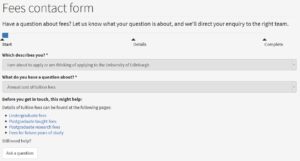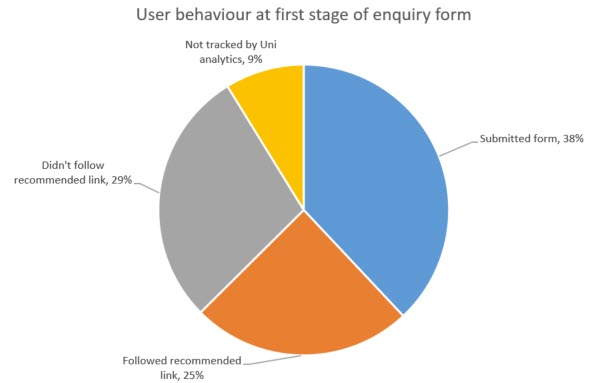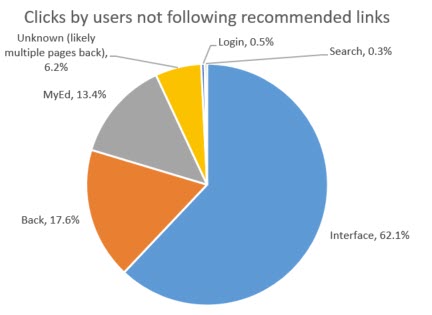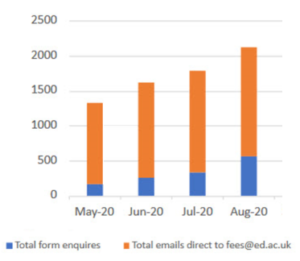Encouraging self service and cutting enquiries for the Fees Service
It’s a little over a year since we delivered our first user-centred enhancement project and I’ve been looking at analytics to dig deeper into how we’ve influenced website visitor behaviour to reduce unnecessary email enquiries. Analysis shows we influenced over 25% to self serve rather than make an enquiry.
Context
We undertook the project from December 2019 to May 2020, resulting in the redesign of presentation of tuition fees content and data to students on multiple websites, and changes in how online content and email enquiries are handled on an ongoing basis.
A key aspect of this work was to redesign the flow of website visitors to points of contact with the Tuition Fees Service, with the intention of:
- Improving website visitor self-service, so reducing unnecessary enquiries
- Improving insight into service user behaviour to inform further enhancement
- Increase efficiency of response to enquiries by the Fees Service
Since the project concluded, we continue to meet with the Fees Service Team on a quarterly basis to review trends in email enquiries and identify where enhancements to the web form and the website may influence student behaviour further.
Read my previous blog post on our enquiry analysis review work with the Fees Service
So we already knew from our quarterly meetings that the Fees Service Team had seen an improvement in the nature of the enquiries they were receiving, but I wanted to see if we could find corresponding evidence in how visitors behave on the website.
The design of the enquiry form
As well as better channelling enquiries, the use of a web form also helps website visitors to better help themselves and thereby reduce the number of enquiries submitted.

We designed the Fees Service webform to encourage user self service, to gather better enquiry information for more efficient resolution, and to give us greater insight into user behaviour which in turn drives further improvement.
We collaborated closely with the Fees Service to ensure that when a website visitor identifies themselves and the nature of their enquiry, they are then presented with links that help them to answer their question independently.
The process of designing the function of the form, the structure of the website and the nature of the website content to reach this point was done collaboratively and iteratively, involving testing with students at each stage.
See the web form live on the Fees Service website
Understanding the website enquirer flow
I looked at data from 1 September 2020, which was the last significant point of substantial change to the webform’s design, informed by previous data analysis and testing with users.

Google Analytics showed that nearly 9% abandoned the University website at the first stage of the web form.
Of the visitors who arrived at the initial page of the web form, just under 9% then visited a page not tracked by University website analytics. This is likely to be a page not in the University’s web estate although some University web pages are not tracked, so we can’t say this with absolute certainty.

One in four visitors used our recommended links to self serve rather than make an enquiry
Of those who stayed on pages tracked by us:
- 38% submitted an enquiry via the web form
- 25% attempted to self-serve by following a link we recommended
- 29% visited another page tracked by University website analytics
Improved self service
The introduction of the web form which focuses on what the Fees Service understand to be top tasks, and ensuring the website services these top tasks, has encouraged self-help behaviour among 1 in 4 potential enquirers.
Introduction of the form is also helping to ensure that more enquirers provide the information the Fees Service need to respond more quickly and with fewer interactions before resolving.
Learn more about top tasks on the Website and Communications blog
Behaviour of users not following our designed routes
We also analysed the behaviour of website visitors who visited another web page in the University, rather than abandon, make an enquiry or follow one of our recommendations.

Considering only the 29% who visited another page tracked by University website analytics:
- 62% clicked another link present in the form interface (mainly: the Tuition Fees Contact us page, the Tuition Fees homepage or the University homepage)
- 18% visited a page elsewhere that includes a direct link to the web form. We can confidently assume they used the back button to do this
- 13% logged into MyEd
- 6% we have classified as ‘Unknown’ as on these pages there is no clear hypertext link to the web form. The vast majority of those reviewed were either pages on the Finance website, or on school programme pages. Our assumption is that the visitor used their browser’s functionality to go back multiple pages in a single click.
- The remainder either logged into an EASE authenticated system (other than MyEd) or used the website search.
Conclusion
The data shows that the website enquiry form is influencing visitors in positive ways that reduce enquiries into the service.
The adoption of a form in itself means that such data collection is possible in the first place. Were the site still to contain multiple mentions of the fees@ed.ac.uk email address this learning simply would not be possible.
There is more to do though. The Fees Service email address has been in use for so long, and it appears in so many other websites, applications and publications that it will be a very long time before it is not the primary route to enquiry. This data shows how direct contact via the email address is still the primary route to the Fees Service inbox.

The majority of enquiries still come via email which shows the potential for further cuts in unneccessary enquiries if more web form use can be encouraged.
When around 80% of enquiries continue to arrive in the Fees Service inbox via direct email it’s clear that investment in ongoing promotion of the form and elimination of mentions of the email from the website will bring a substatial benefit both to enquirers and to enquiry management staff.
Read more about this project
More blog posts about our collaboration with the Fees Service




1 replies to “Encouraging self service and cutting enquiries for the Fees Service”